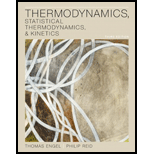
Thermodynamics, Statistical Thermodynamics, & Kinetics
3rd Edition
ISBN: 9780321824004
Author: ENGEL, Thomas/ Reid
Publisher: Pearson College Div
expand_more
expand_more
format_list_bulleted
Question
Chapter 3, Problem 3.24NP
Interpretation Introduction
Interpretation: The differential
Concept Introduction: A differential is said to be exact only if the integral of the function is path independent. (Independent of path means that the system depends only on starting and finishing points and not on the path followed to reach the finishing point.) So,
for a differential,
Expert Solution & Answer
Want to see the full answer?
Check out a sample textbook solution
Students have asked these similar questions
An x-ray has a frequency of 3.33 × 1018 What is the wavelength of this light?
Choose the Lewis structure for the compound below:
H2CCHOCH2CH(CH3)2
HH
H
:d
H
H
H C.
Η
H
H
HH
H
H
H
H.
H
H
H
HH
H
H
H
H
H-
H
H
H
C-H
H
H
HHHH
Each of the highlighted carbon atoms
is connected to
hydrogen atoms.
Chapter 3 Solutions
Thermodynamics, Statistical Thermodynamics, & Kinetics
Ch. 3 - Prob. 3.1CPCh. 3 - Prob. 3.2CPCh. 3 - Prob. 3.3CPCh. 3 - Prob. 3.4CPCh. 3 - Why can qv be equated with a state function if q...Ch. 3 - Prob. 3.6CPCh. 3 - Prob. 3.7CPCh. 3 - Prob. 3.8CPCh. 3 - Prob. 3.9CPCh. 3 - Why is qv=U only for a constant volume process? Is...
Ch. 3 - Prob. 3.11CPCh. 3 - Why are q and w not state functions?Ch. 3 - Prob. 3.13CPCh. 3 - What is the relationship between a state function...Ch. 3 - Prob. 3.15CPCh. 3 - Is the following statement always, never, or...Ch. 3 - Is the following statement always, never, or...Ch. 3 - Prob. 3.18CPCh. 3 - Prob. 3.19CPCh. 3 - Is the expression UV=T2T1CVdT=nT1T2CV,mdT only...Ch. 3 - Prob. 3.1NPCh. 3 - Prob. 3.2NPCh. 3 - Prob. 3.3NPCh. 3 - Prob. 3.4NPCh. 3 - Prob. 3.5NPCh. 3 - Prob. 3.6NPCh. 3 - Integrate the expression =1/VV/TP assuming that ...Ch. 3 - Prob. 3.8NPCh. 3 - Prob. 3.9NPCh. 3 - Prob. 3.10NPCh. 3 - Prob. 3.11NPCh. 3 - Calculate w, q, H, and U for the process in which...Ch. 3 - Prob. 3.13NPCh. 3 - Prob. 3.14NPCh. 3 - Prob. 3.15NPCh. 3 - Prob. 3.16NPCh. 3 - Prob. 3.17NPCh. 3 - Prob. 3.18NPCh. 3 - Prob. 3.19NPCh. 3 - Prob. 3.20NPCh. 3 - Prob. 3.21NPCh. 3 - Prob. 3.22NPCh. 3 - Derive the following relation, UVmT=3a2TVmVm+b for...Ch. 3 - Prob. 3.24NPCh. 3 - Prob. 3.25NPCh. 3 - Prob. 3.26NPCh. 3 - Prob. 3.27NPCh. 3 - Prob. 3.28NPCh. 3 - Prob. 3.29NPCh. 3 - Prob. 3.30NPCh. 3 - Prob. 3.31NPCh. 3 - Prob. 3.32NPCh. 3 - Prob. 3.33NPCh. 3 - Prob. 3.34NPCh. 3 - Derive the equation H/TV=CV+V/k from basic...Ch. 3 - Prob. 3.36NPCh. 3 - Prob. 3.37NPCh. 3 - Show that CVVT=T2PT2VCh. 3 - Prob. 3.39NP
Knowledge Booster
Similar questions
- く Complete the reaction in the drawing area below by adding the major products to the right-hand side. If there won't be any products, because nothing will happen under these reaction conditions, check the box under the drawing area instead. Note: if the products contain one or more pairs of enantiomers, don't worry about drawing each enantiomer with dash and wedge bonds. Just draw one molecule to represent each pair of enantiomers, using line bonds at the chiral center. More... No reaction. Explanation Check O + G 1. Na O Me Click and drag to start drawing a structure. 2. H + 2025 McGraw Hill LLC. All Rights Reserved. Terms of Use | Privacy Center | Accessibility 000 Ar Parrow_forwardDraw a tetramer of this alternating copolymer.arrow_forwardH I T H HH H -H C. H- Identify and select all structures below that represent a constitutional isomer(s) of the compound shown above. H- H CIH H H H HHHH H H 0 ·H H– 冊 CH CHI HH C- H- H H- H H A. H H C H H- -H HH H B. H- -H D. H H H H • H -H E. -H H H HICH T HHH F. H-arrow_forward
- Polylactic acid (shown below) is a biodegradable polymer used for food packaging. Identify the monomer(s) used in the production of this polymer using a condensation process.arrow_forwardDraw the product of the reaction shown below. Ignore small byproducts that would evaporate pleasearrow_forwardPoly(ethylene adipate) is a biodegradable polyester (shown below). Identify the type of polymerization process used in the production of this polymer.arrow_forward
- Polymers may be composed of thousands of monomers. draw two repeat units(dimer) of the polymer formed in this reaction. assume there are hydrogen atoms on the two ends of the dimer. ignore inorganic byproducts pleasearrow_forwardDraw the product of the reaction shown below. Use a dash or wedge bond to indicate stereochemistry of substituents on asymmetric centers, Ignore inorganic byproductsarrow_forwardDraw the product of this reaction please. Ignore inorganic byproductsarrow_forward
- One of the pi molecular orbitals of 1,3-butadiene (CH2=CHCH=CH2) is shown below. Please identify the number of nodal planes perpendicular to the bonding axisarrow_forwardDraw the monomers required to synthesize this condensation polymer please.arrow_forwardProvide the correct systematic name for the compound shown here. Please take into account the keyboard options belowarrow_forward
arrow_back_ios
SEE MORE QUESTIONS
arrow_forward_ios
Recommended textbooks for you
 Physical ChemistryChemistryISBN:9781133958437Author:Ball, David W. (david Warren), BAER, TomasPublisher:Wadsworth Cengage Learning,
Physical ChemistryChemistryISBN:9781133958437Author:Ball, David W. (david Warren), BAER, TomasPublisher:Wadsworth Cengage Learning,

Physical Chemistry
Chemistry
ISBN:9781133958437
Author:Ball, David W. (david Warren), BAER, Tomas
Publisher:Wadsworth Cengage Learning,